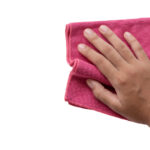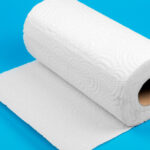After a refreshing shower, there’s nothing more tempting than to wrap up our hair and dive straight to bed.

Sleeping with wet hair seems harmless at worst as long as you have your luscious locks tucked away.
However, hair experts warn that snoozing with a wet microfiber hair towel comes with some serious risks.
Why Sleeping in a Wet Towel Can Be Problematic
Wrapping wet strands in a microfiber hair towel before bedtime might feel comfortable. Unfortunately, this habit can cause some severe damage to your hair and scalp health.
Promotes Bacteria and Fungus Growth
When damp hair remains bundled up all night, it creates the optimum environment for bacteria and fungus to thrive. The moisture gets trapped within the hair fibers while your body warmth proliferates the growth.
As you toss and turn, the wet towel transfers bacteria to your pillowcase and linens. Over time, the grime adds up and can lead to infections on your scalp.
Fungal buildup is also no joke. Resting all night with a soaked head will likely result in painful dandruff and even hair fall.
Key Takeaway: Sleeping with wet hair in a towel allows bacteria and fungus to grow out of control. This causes severe scalp issues over time.
Causes Hair Breakage
Wet hair in any form is extremely fragile. When you sleep with bundled up tresses, any movement yanks and tugs on the delicate stands. The friction and pressure lead to irreversible breakage and split ends.
By the morning, you may notice clumps of hair on your towel and pillow. Repeated breakage from sleeping on wet locks can also accelerate permanent hair loss.
Tangles and Knots Become Unmanageable
As you change positions at night, wet hair fibers have a tendency to wrap around each other. Sleeping with hair stuffed inside a towel makes this tangling effect even worse.
Untangling knots without ripping hair out requires patience and care. Aggressive combing of fragile wet hair causes more harm than good.
Save yourself the agony of tugging out knots each morning. Make sure to dry hair thoroughly before going to bed.
Key Takeaway: Wet hair is prone to extreme matting and tangles if you sleep with it bundled in a towel. Combing it causes breakage.
Can Make Hair Appear Limp and Dull
Without access to oxygen, wet hair cannot refortify itself with nourishing oils overnight. Wrapping your crown in a towel prevents sebum from spreading evenly across the scalp and strands.
In the morning, you may notice your hair looks flatter and less glossy. Over time, the lack of oxygen deteriorates hair health making it appear limp.
Is It Ever Safe to Sleep in a Hair Towel?
Ideally, you should squeeze out excess moisture and let hair dry naturally before sleeping. However, wearing a towel at night may work for some people if done correctly.
Straight and Oily Hair
Those blessed with pin-straight hair may benefit from sleeping in a towel wrap. The fabric absorbs excess oil so hair appears voluminous rather than flat.
If you have heavily oily roots, drying straight hair overnight can also prevent strands from getting slick and limp.
Key Tip: Use a fresh lint-free cotton t-shirt instead of terry cloth to wrap straight oily hair.
Naturally Curly or Textured Hair
For people with waves, curls, and coils sleeping with damp hair wrapped can encourage their texture. As you toss and turn, the fibers take on the shape of the towel.
When you wake up, gently unfurl the towel to reveal perfectly defined curls or beachy waves. Those with thick curly manes can scrunch their damp ringlets with some curl cream before wrapping hair up.
Key Tip: Comb coils before bed to avoid painful tangles in textured hair. Use a wide-tooth comb and avoid ripping through knots.
Must Use a Clean Breathable Fabric
Whether you have straight, wavy, or curly hair, the fabric you choose for overnight drying is crucial.
Cotton t-shirts, microfiber towels, and specialty hair wraps allow ventilation so strands stay healthy. These fabrics also have smooth surfaces that minimize friction.
Terry cloth hair towels feel soft initially but their loops can snag onto hair. Silk and satin hair wraps prevent moisture from evaporating making hair damp all night.
Can’t Sleep Too Deeply
Even textured hair types prone to defined curls must exercise caution when sleeping wrapped up. If you are a wild sleeper who tosses and turns all night, wet hair can still tangle and break.
Set your alarm to wake up halfway through the night. Gently adjust the wrap to untangle hair before falling back asleep. Pay attention to any pulling sensation on your scalp.
Correct Method to Wrap Wet Hair Before Bed
If you decide to take the risk, use these pro tips to wrap damp hair safely:
- Shampoo and condition hair as normal before bedtime. Rinse thoroughly with cool water to close the cuticles. Avoid scalding hot showers that can dry out your hair.
- Gently squeeze out excess moisture with an old cotton t-shirt or paper towels. Rough terry cloth towels can damage fragile wet hair. Your hair should be damp but not dripping wet before wrapping.
- Apply any leave-in conditioning treatments before bed to nourish strands overnight. A nourishing overnight hair mask replenishes hair as you sleep.
- Use a wide-tooth comb to untangle hair gently. Never rip through knots in wet hair or else you may tug out strands. Work in small sections from tips to roots.
- Create your desired hairstyle by scrunching, braiding, twisting or bunning hair before wrapping it up. This technique encourages waves, curls, and volume as you sleep. Use curl cream to define slippery straight locks.
- Wrap hair gently in a breathable fabric like microfiber towel, old cotton tee, or specialty hair wrap. Avoid silk and satin fabrics that block airflow.
- Secure the wrap loosely around your head. Tucking in the folds under your ears and nape of the neck to anchor the fabric. The key is to avoid tight styles that pull the scalp and hair.
- Sleep on a silk pillowcase to minimize friction. Adjust wrap if needed without ripping hair.
- In the morning, gently unfurl wrap and style hair as desired. Use leave-in treatments to smooth flyaways and nourish strands. Avoid brushing to prevent excess breakage after sleeping.
| Hair Type | Recommended Fabric | Caution |
|---|---|---|
| Straight | Cotton t-shirt or microfiber | Can still rip out hair if you move too much |
| Wavy/Curly | Microfiber towel or specialty wrap | Monitor for tightness and tangles |
| Coiled Textured | Breathable fabric like microfiber | Must gently detangle beforehand |
By carefully considering your curl pattern and sleeping habits, you may decide overnight wrapping benefits your hair. Pay attention to any increased shedding, knots or breakouts indicating potential damage from wet wraps.
Key Tip: Always use a freshly laundered wrap and wash it after every use.Dirty towels transfer bacteria back to clean damp hair.
How to Refresh Hair After Sleeping Wrapped Up
You wake up with hair still holding onto waves and curls sculpted by the wrap. Avoid brushing or combing strands to keep the style intact. However, sleeping can still leave hair looking lifeless even after careful wrapping.
Give roots and ends a boost with these refreshing tricks:
Sleeping on Dry Hair to Prevent Damage
If you want to wake up with salon-worthy locks every morning, you need to build a consistent haircare routine. Wrap drying wet strands at night may not fit your schedule or curl pattern.
Here are some nighttime tips for maintaining healthy hair day-to-day:
FAQs
Can I catch a cold from sleeping with wet hair?
While damp hair may feel uncomfortable, it will not directly cause illness. As long as you wrap up in breathable loose fabrics, you should stay healthy.
Which is better for overnight drying: towel or t-shirt?
Avoid bulky terry cloth towels that can be too abrasive for fragile wet hair. Well-worn cotton t-shirts or microfiber hair towels are ultra-gentle for overnight styling.
How do I make my curls last after unwrapping hair?
The key is not to disrupt curl formation by combing or brushing. Gently shake out bundles then use finishing cream to set curls without frizz or flyaways.
What kind of leave-in treatments prevent hygral fatigue in damp hair?
Hydrating masks containing moisture-binding humectants like glycerin, honey, and panthenol prevent the swell-shrink cycle of wet hair overnight.
Can I reuse my hair wrap or wash it after every night?
For hygiene, wash hair wraps after every use in hot water. Dirty towels transfer bacteria and buildup back onto clean damp hair. This causes irritation over time.
Conclusion
Leaving damp hair wrapped in a towel or t-shirt overnight seems like an easy shortcut for perfect waves and glossy strands in the morning. However, hair experts warn that sleeping in bundles can lead to breakage, fall out, and scalp irritation for all hair types.
If you decide snuggling up in a hair towel is worth the risks, stick to loose breathable fabrics. Avoid slippery silk and satin since these can tug on hair without absorbing moisture properly overnight.








